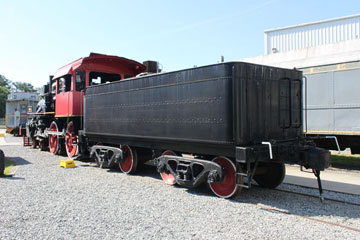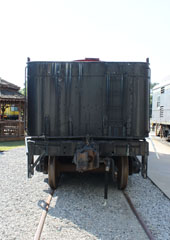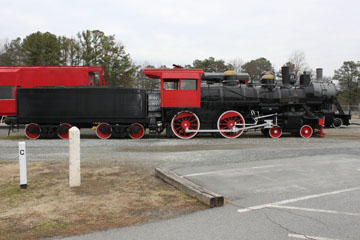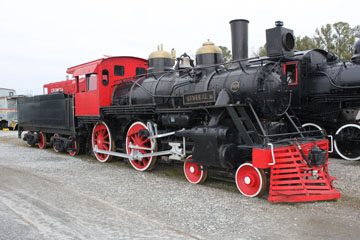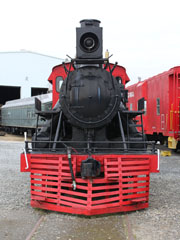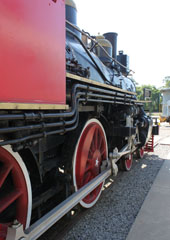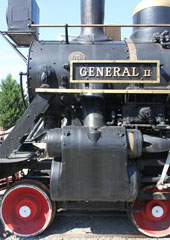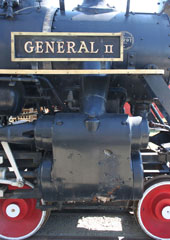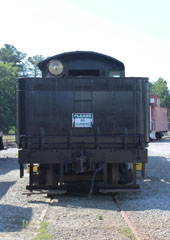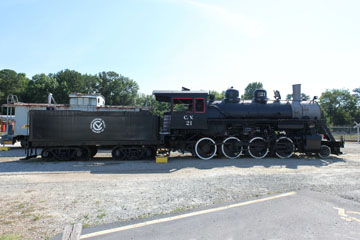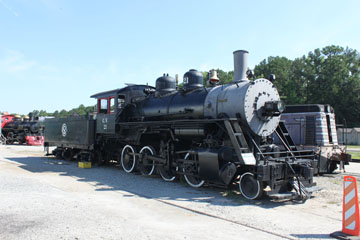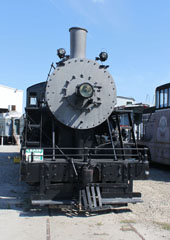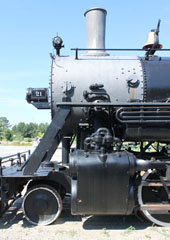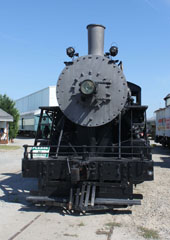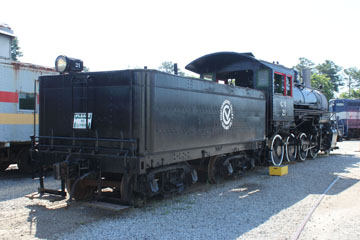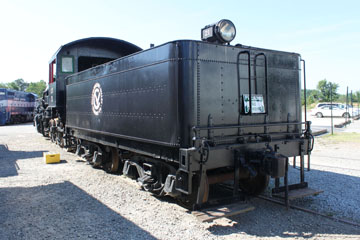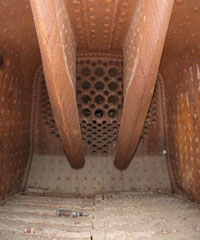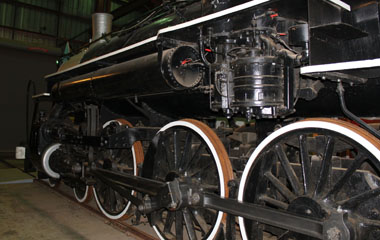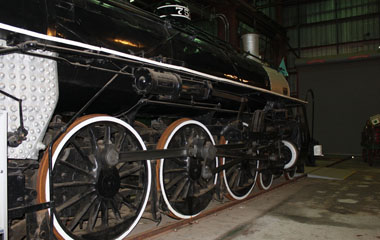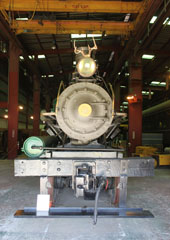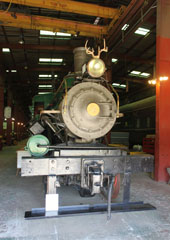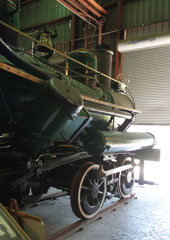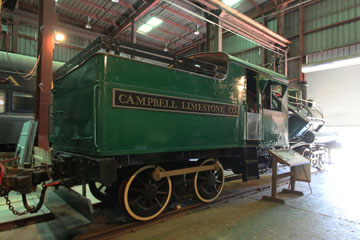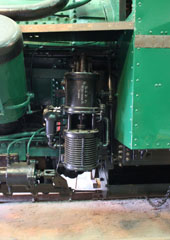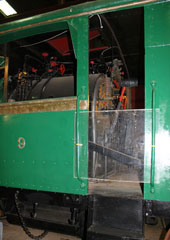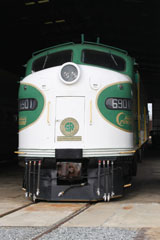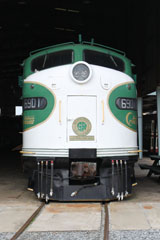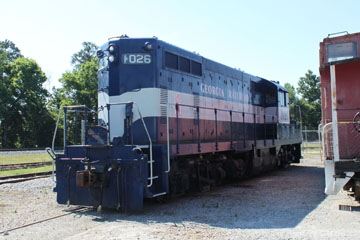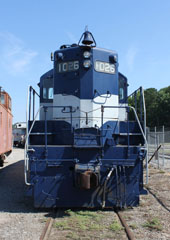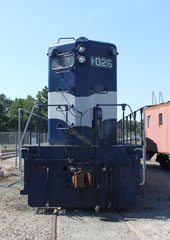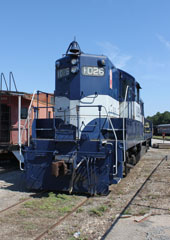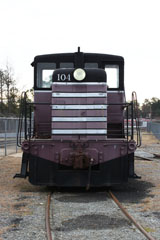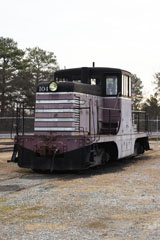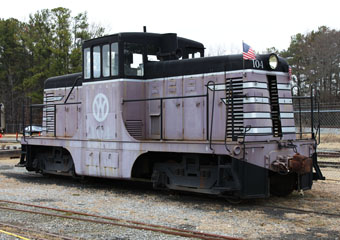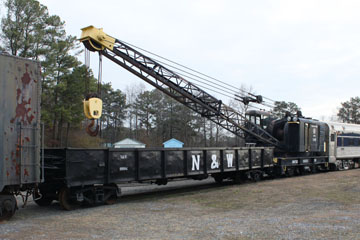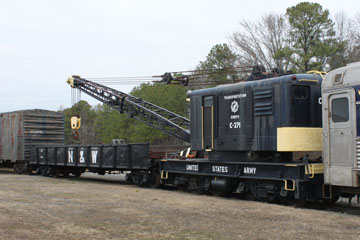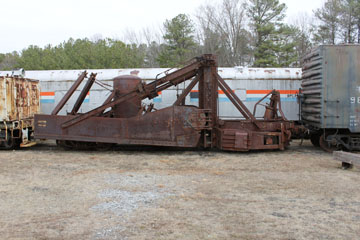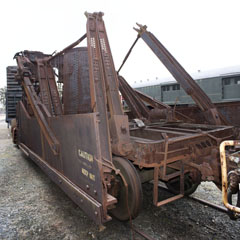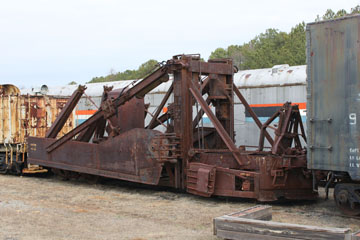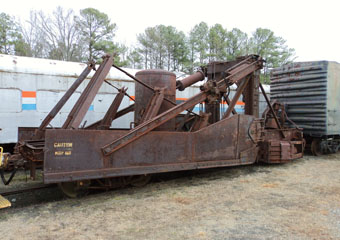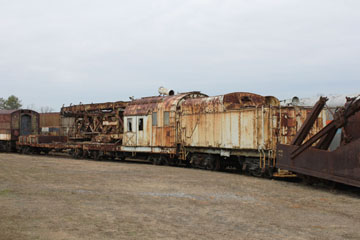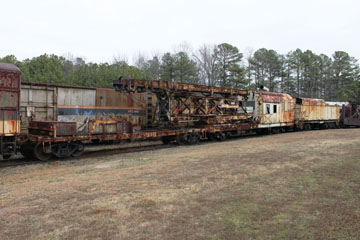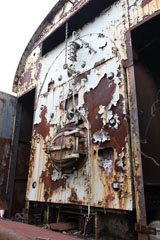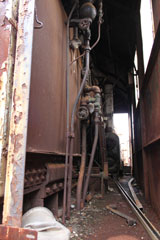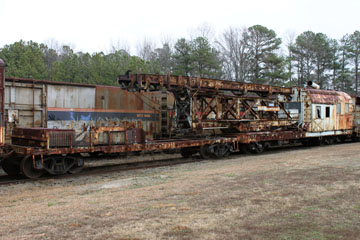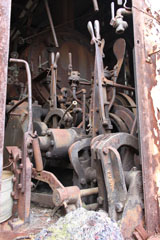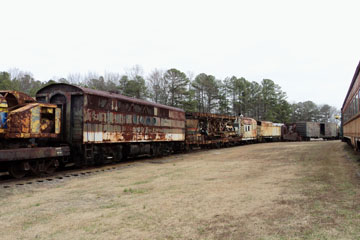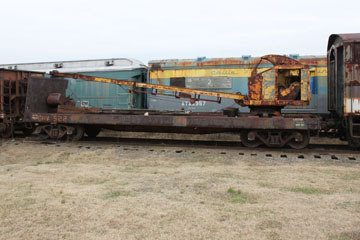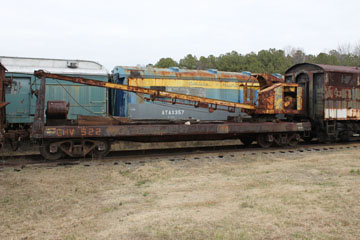

The Southeastern Railway Museum is located at 3595 Buford Highway NW, in south west Duluth, GA. Formed in 1970 by the Atlanta Chapter of the NHRS, over the years it has accumulated an interesting collection of motive power, passenger coaches, freight cars, cabooses and maintenance of way equipment. In 2000, the museum was given the title of being Georgia's official transportation history museum. The museum is open 10.00-5.00 Thursday through Saturday throughout the year and offers educational field trips and tours.
There are many rail-related artefacts on display in the main museum building and the grounds contain the restored 1871 Duluth passenger train depot, and a G16/Park train ride. A model railroad is housed in Building 1. Visitors can take a short train ride on restored cabooses hauled by vintage diesel locomotives over track which runs the length of the property. The museum also works on the restoration of its collection on a rotating basis as funds allow.
I have visited a couple of times and the photos on this page are from both visits.

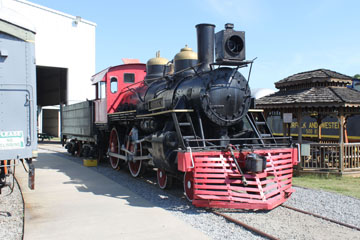

This American (4-4-0) type locomotive was built by the Baldwin Locomotive Works in Philadelphia, PA, in 1919 at a cost of $19,050 for the Red River & Gulf Railroad in Louisiana. Incorporated in 1905 to operate a railroad from Lecompte, LA, the Red River & Gulf served the logging industry and sawmills at Longleaf, Meridian and Glenmora over 115 miles of trackage.
Although the RR&G operated until 1954, #104 had a short life on that line. After less than ten years in service it was retired in January 1928 but wasn't sold until 1946.
In 1946, the engine went to the Comite Southern of Amite, LA, where it was renumbered #1. It was then acquired by the Louisiana Eastern of Shiloh, LA, in 1950.
It was sold to the Stone Mountain Scenic Railroad in 1961, where it was altered to resemble the "General", a locomotive involved in a Civil War chase through Georgia (you can see both the original "General" and the "Texas", another locomotive involved in the chase, on the Southern Museum & Great Locomotive Chase page of this website).

This Consolidation type (2-8-0) locomotive was built in 1924 by Baldwin for the Tennessee, Alabama & Georgia Railway to haul passenger trains. Numbered #201 on the TA&G, it was renumbered #21 when it was purchased by the Chattahoochee Valley Railroad in 1935.
The CHV ran from West Point, GA, where it connected with the Atlanta & West Point, to Bleaker, AL, connecting there to the Central of Georgia. Owned by the West Point Manufacturing Co., the CHV served several cotton mills along the west bank of the Chattahoochee River.
#21 weighs 144,000 lbs, 132,000 lbs on its 50" drivers with 20" x 26" cylinders. The grate is 37 sq ft, the firebox 167 sq ft and total heating surface is 2,093 sq ft including 442 sq ft superheating.
Operating at a boiler pressure of 180 psi, it delivered 31,800 lbs tractive effort.


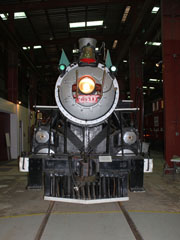
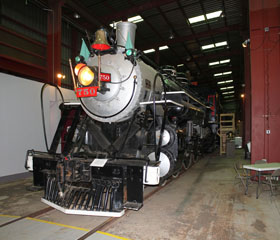

#750 hauled its first excursion in 1964, and ran many double headers with SOU #722 from 1970 to 1975.
It then started a complete overhaul but did not return to steam until 1983, working for five more years before retiring for good in 1988. However, as the photo below shows, #750 will need a lot of work before steaming again.
Built by Alco in 1910 for the Florida East Coast as #80, this Pacific (4-6-2) type locomotive was sold to the Savannah & Atlantic in 1935 and renumbered #750. Donated to the Atlanta Chapter of the NHRS in 1962, it moved to the museum in 1984.
Weighing 366,000 lbs (204,000 lbs engine and 162,000 lbs tender light), #750 has 69" drivers and 22" x 28" cylinders. With a 160 sq ft firebox, 47.1 sq ft grate and combined heating surface of 2,551 sq ft (440 sq ft superheating added in the 1920s), it operated at a boiler pressure of 200 psi, delivering 28,300 lbs tractive effort.

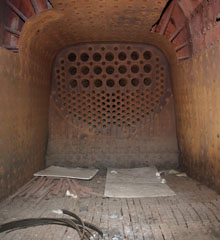

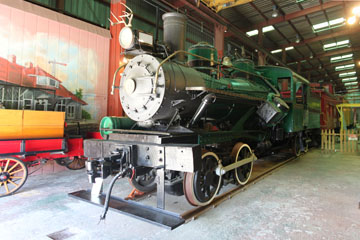
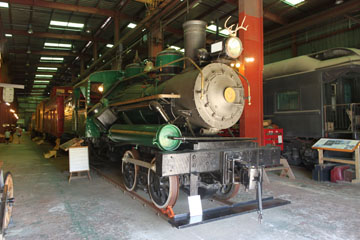
This 2 truck Heisler was built in 1923 for the Kentucky Lumber Co., in Williamsburg, KY, as #9 by the Heisler Locomotive Works in Erie, PA. It was successively sold to Carolina Tie & Lumber,
the Santee River Hardwood Co., Campbell Limestone and Vulcan Materials before being donated to the Atlanta Chapter of the NHRS in 1979.
#9 weighs 110,000 lbs, and has 38" drivers and 15½" x 14" cylinders. Operating at a boiler
pressure of 125 psi, it delivered 9,405 lbs tractive effort.

Starting with the E7, EMD created a classic look with their bulldog
nosed E7, E8 and E9 units. Many have been preserved and a number still operate on short line and heritage railroad.
You can see SOU #6900 on the
North Carolina Transportation Museum page of this website, and PRR E8 #5794 liveried as FEC #1594 on the Gold Coast Railroad Museum page.
#6901 was parked in the train shed when I visited the museum, which made it difficult to get good photos.
This is one of four hundred and forty-nine E8 A units manufactured by EMD between 1949 and 1953. Their two 1,125 hp 567B 12 cylinder prime movers each drove their own generator to power the unit's four GM D37 traction motors. Four hundred and forty-six A units were delivered to US railroads and three to Canadian. The cabless E8 B unit was manufactured from 1949 to 1954, and forty-six were produced, all for US railroads. Purchased by Southern in 1951, #6901 was originally numbered #2924, and was one of seven E8 A units owned by the railroad.


#104 was delivered to New York, Ontario & Western Railway in 1941. This regional railroad had its origins in the New York & Oswego Midland Railroad chartered in 1868. The NYO&W's main line ran from Weehawken, NJ, to the Lake Ontario port city of Oswego, NY, but it also had branch lines to Scranton, PA, Kingston, Port Jervis, Monticello, Delhi, Utica and Rome, NY.
The NYO&W entered bankruptcy in 1937 but continued to operate, although on declining revenues, until it was finally liquidated in 1957.
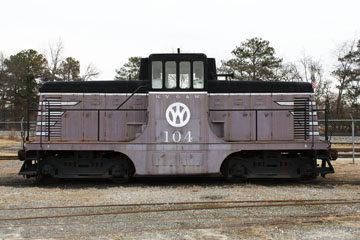

#104 was one of five 360 hp GE 44-Ton switchers bought by the NYO&W between 1941 and 1942 (#101-#105). It is 28' 4" long and weighs 90,000 lbs. With its two Caterpillar D 1700 diesel engines driving four GE 752AF traction motors, it is still operational, and delivers 12,400 lbs continuous tractive effort at 12 mph.
GE produced three hundred and eighty-five of these units from 1940 to 1956, thirty-seven for export. Designed for light industrial switching, many remain in service or are preserved, and #104 still hauls passenger trains at the museum.

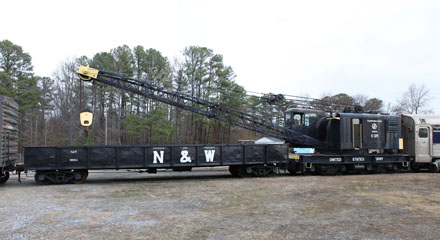
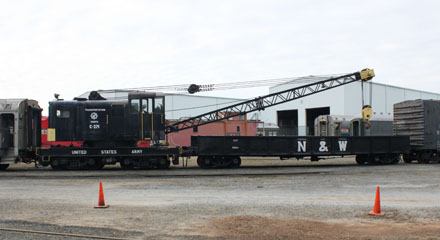
This 50 ton self-propelled crane was built by the American Hoist & Derrick Company in 1953 for the US Army Transportation Corps. Under the brand American
DiesElectric, the company produced cranes powered by diesel-electric engines of the kind used on locomotives. Direct diesel power was supplied to the deck and boom, while electric power was supplied to the crane's trucks. This allowed it to move itself along the track, as well as being able to switch cars on sidings.
#C-271 is on display with Norfolk & Western Class G-1 gondola car #99984. The car was built by Virginia Bridge Works in 1940 and donated to the museum in 1963.

Oswald F. Jordan started making spreaders in East Chicago in 1911. The O. F. Jordan Company was in business until 1964, when it was bought by Jackson Vibrators, now part of Harsco Rail, a railroad maintenance company.
Few spreaders are used today. Their work has been taken over by diggers, cherry pickers and snowplows.
Not much seems to be known about this piece of equipment. Spreaders removed snow, spread gravel, built banks and trimmed embankments of brush along the sides of track. They were pushed by a locomotive, which also supplied power, but were operated by a separate crew.
#JX635 would once have had a cab like #360 shown on the Nevada Northern Railway Museum page of this website.

This steam powered pile driver was built by Industrial Brownhoist of Bay City, MI, in 1929. It ended its operational life as Western Railway of Alabama #20.
Piles were used in building bridges, shoring up embankments or as foundations for large
buildings, so #20 would have had a varied career. It would have been hauled to work sites by another locomotive, but could also move under its own power. It has 33" wheels and delivered 8,000 lbs tractive effort.
The tender, WRA #7302, has a 12 ton coal and 7,000 gallon water capacity. On the right, #20's fire door and some of
the controls. Below, WRA boom car #7001 (note the ballasting).

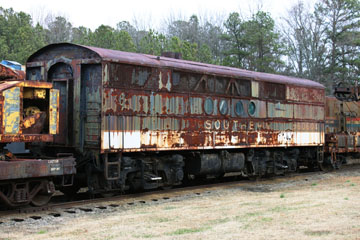

EMD built five hundred and fifty-five FT A units and five hundred and forty-one cabless B units from 1939 to 1945, all for US railroads. The first in EMD's F series, they are credited with convincing many railroads to convert to diesel power.
FTs were designed to haul freight (hence the "F" in "FT") and were generally marketed as semi-permanently coupled A-B sets making a single locomotive of 2,700 hp (hence the "T" in "FT"). They had a 567B 16 cylinder prime mover powering a GM D12 generator to drive four GM D7 traction motors.
Many railroads coupled sets back to back to make
a four-unit A-B-B-A locomotive rated at 5,400 hp, and some bought semi-permanently coupled
A-B-A three-unit sets of 4,050 hp. Multiple unit controls allowed all units in a consist to be run from one cab. Each unit developed 40,000 lbs tractive effort at 9.3 mph, with a top speed of 65 mph.
Southern bought thirty-six FT A units and twenty-eight FT B units. At some point, #960604's engines were removed, leaving only the steam generator to heat passenger cars.



This integrated Burro crane and crane car was built by the Cullen-Friestedt Co., of Chicago, IL. The cranes were named after the favoured pack animal of the old West, a Spanish breed of donkey.
Used on maintenance of way work on the Chattahoochee Valley Railway, the boom could be fitted with different tools depending on the job.







